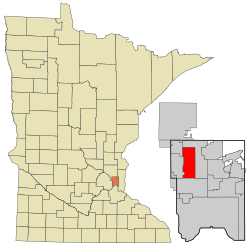Arden Hills, Minnesota facts for kids
Quick facts for kids
Arden Hills
|
|
|---|---|

Location of the city of Arden Hills
within Ramsey County, Minnesota |
|
| Country | United States |
| State | Minnesota |
| County | Ramsey |
| Incorporated | February 14, 1951 |
| Area | |
| • Total | 9.60 sq mi (24.86 km2) |
| • Land | 8.46 sq mi (21.92 km2) |
| • Water | 1.14 sq mi (2.94 km2) |
| Elevation | 915 ft (279 m) |
| Population
(2020)
|
|
| • Total | 9,939 |
| • Estimate
(2022)
|
9,592 |
| • Density | 1,174.13/sq mi (453.34/km2) |
| Time zone | UTC-6 (Central) |
| • Summer (DST) | UTC-5 (CDT) |
| ZIP code |
55112
|
| Area code(s) | 651 |
| FIPS code | 27-02026 |
| GNIS feature ID | 2393979 |
Arden Hills (/ˈɑːrdən/ AR-dən) is a city in Ramsey County, Minnesota, United States. In 2020, about 9,939 people lived there.
Arden Hills is home to Bethel University and part of the University of Northwestern – St. Paul campus. Big companies like Land O'Lakes and Boston Scientific also have their main offices or large campuses in the city.
Contents
Geography
Arden Hills covers about 9.65 square miles (24.99 square kilometers). Most of this area is land, with a smaller part being water.
Several important roads run through the city, including Interstate Highway 35W, Interstate Highway 694, and U.S. Highway 10. These highways help people travel easily in and out of Arden Hills.
Population and People
| Historical population | |||
|---|---|---|---|
| Census | Pop. | %± | |
| 1960 | 3,930 | — | |
| 1970 | 5,149 | 31.0% | |
| 1980 | 8,012 | 55.6% | |
| 1990 | 9,199 | 14.8% | |
| 2000 | 9,652 | 4.9% | |
| 2010 | 9,552 | −1.0% | |
| 2020 | 9,939 | 4.1% | |
| 2022 (est.) | 9,592 | 0.4% | |
| U.S. Decennial Census 2020 Census |
|||
In 2010, there were 9,552 people living in Arden Hills. The city had 2,957 households, which are groups of people living together.
Most residents (about 90.3%) were White. Other groups included African American (1.7%), Asian (4.9%), and people from other backgrounds. About 2.8% of the population was Hispanic or Latino.
The average age in the city was 34.8 years old. Many young people (16.1%) were under 18, and a good number (26.1%) were between 18 and 24, often students at the local universities.
Education
Arden Hills has several schools and universities:
- Bethel University: A private Christian university.
- University of Northwestern – St. Paul: Part of its campus is in Arden Hills, and the rest is in nearby Roseville.
- Mounds View High School: This public high school serves students in grades 9-12. It is one of two high schools in the local school district.
- Valentine Hills: This is the only elementary school located within Arden Hills.
Economy
Arden Hills is an important place for several large businesses. The main office of Land O'Lakes, a well-known food and agriculture company, is located here.
Top Employers
Here are some of the biggest employers in Arden Hills, based on a 2022 report:
| # | Employer | Number of Employees |
|---|---|---|
| 1 | Boston Scientific | 3,000–3,500 |
| 2 | Land O'Lakes Inc. | 1,250–1,750 |
| 3 | University of Northwestern | 1,000–1,500 |
| 4 | Bethel University | 750–1,250 |
| 5 | Presbyterian Homes (Johanna Shores) | 450–550 |
| 6 | Delkor | 300–350 |
| 7 | IntriCon | 250–300 |
| 8 | Venture Solutions, Inc. | 175–225 |
| 9 | Gradient Financial | 150–200 |
| 10 | National Recoveries | 150–200 |
| 11 | Ulteig Engineers, Inc. | 150–200 |
| 12 | Health Partners Arden Hills Clinic | 150–200 |
City Planning and Development
The city has rules for how land can be used and developed. These rules, called the Zoning Code, help make sure that new buildings and projects fit well into the community. They also aim to protect public health and safety.
Sometimes, a new project might need a special permission called a "variance" if it doesn't perfectly follow the rules. This is usually for unique situations where the rules would make it very hard to use the land. A group of volunteer residents called the Planning Commission helps decide if these special permissions should be given.
In 2006, the city made a deal to buy a large part of a former military site. The plan was to build 2,400 new homes and lots of commercial space there, which would be a big change for the city.
Protecting the Environment
Arden Hills cares about protecting its natural areas, especially its lakes and water. The city has a special rule called the Shoreland Ordinance. This rule helps keep public waters clean and healthy by controlling how land near lakes is developed. It also helps protect the natural beauty and value of these areas.
The city is also part of the Rice Creek Watershed District. This group works to reduce storm water runoff, which is when rain flows over land and can carry pollution into lakes and streams. They encourage building in ways that minimize paved surfaces, allowing more water to soak into the ground naturally.
Sports
Arden Hills is home to the Twins Cities Titans, a semi-pro football team that plays in the NEFL league.
New Minnesota Stadium Plan
For a while, Arden Hills was considered as a possible location for a new stadium for the Minnesota Vikings football team. In 2011, officials from Ramsey County and the Vikings agreed on a plan to build a new stadium on the site of the former Twin Cities Army Ammunition Plant in Arden Hills.
The plan was for a very expensive stadium, costing hundreds of millions of dollars. The Vikings, Ramsey County, and Minnesota taxpayers would all help pay for it. However, this plan did not happen. In 2012, the Governor announced that the new stadium would be built in Minneapolis instead, at the site of the Vikings' old home, the Metrodome. The new stadium is now known as U.S. Bank Stadium.
See also
 In Spanish: Arden Hills (Minnesota) para niños
In Spanish: Arden Hills (Minnesota) para niños


